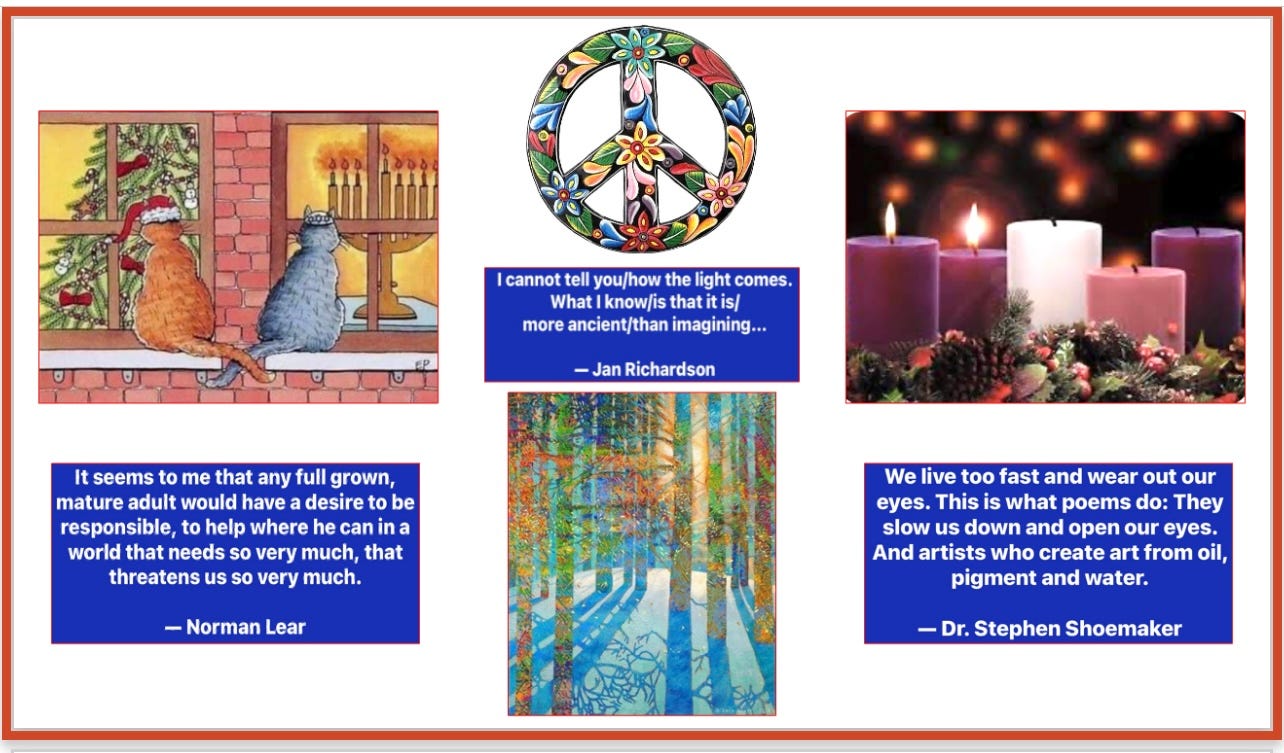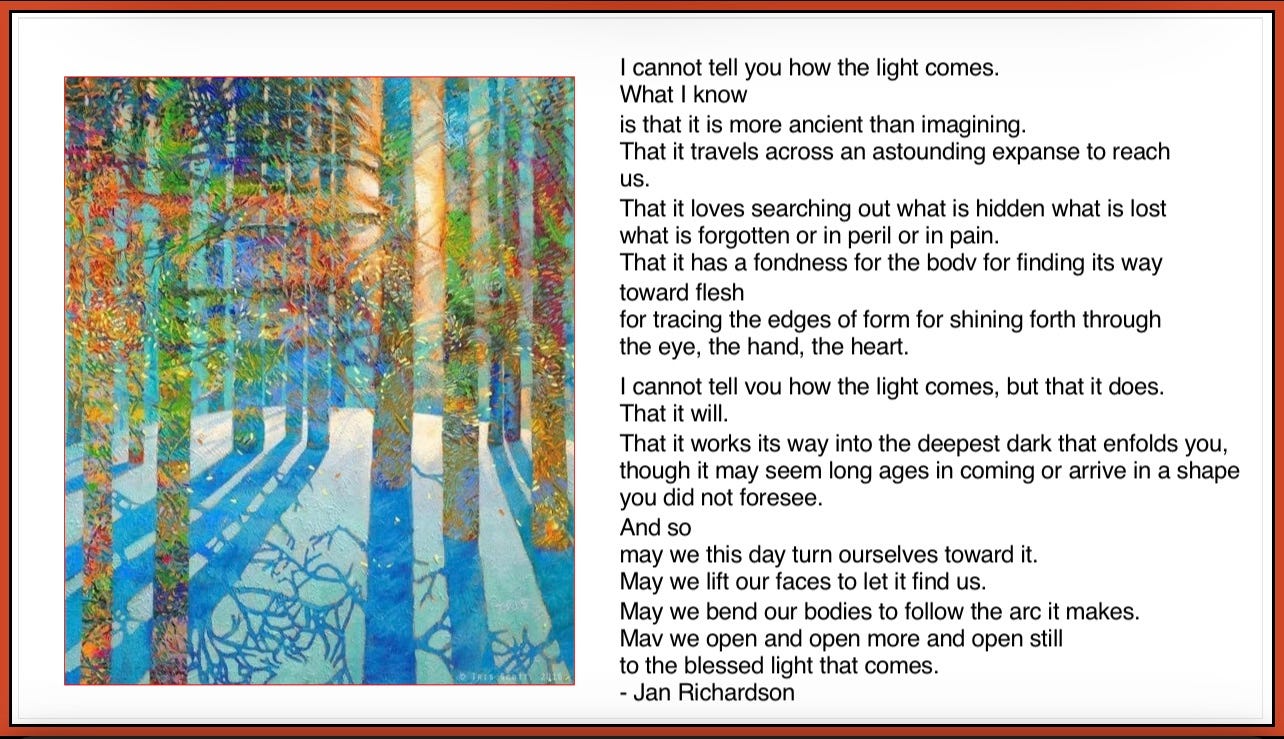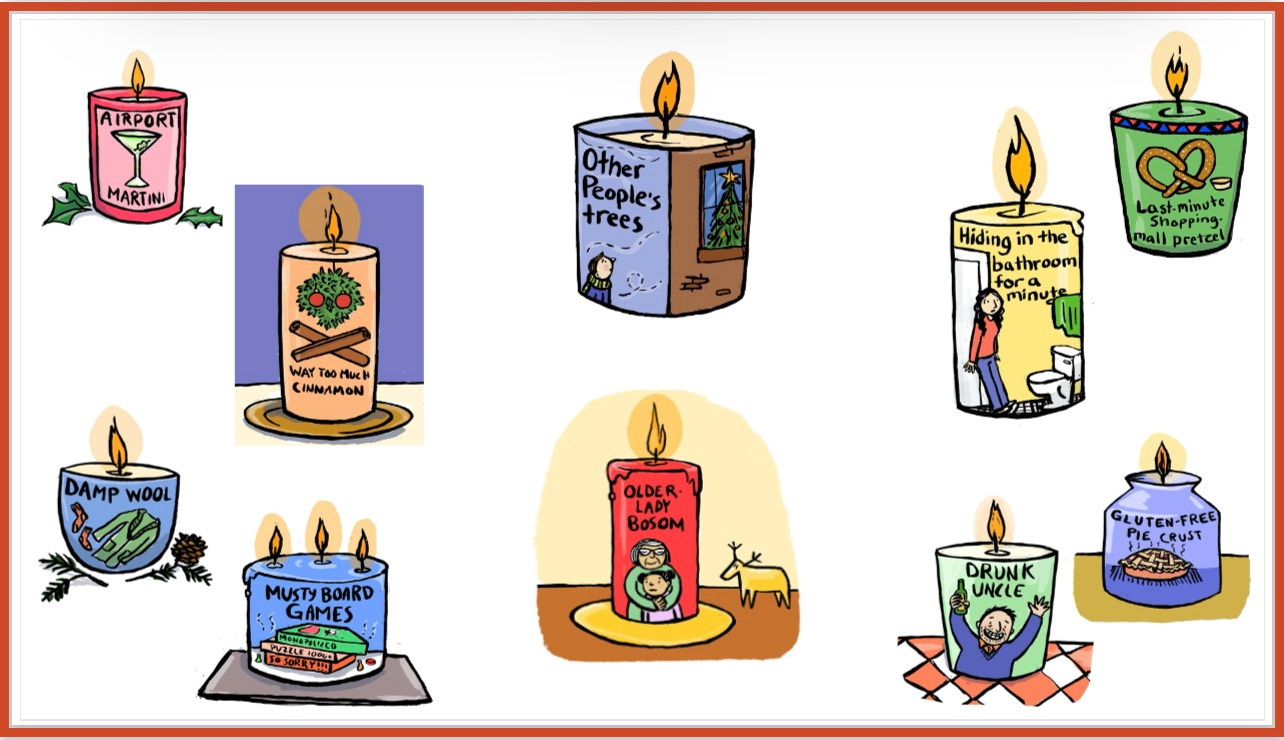Greetings for the season’s many festivals of light.
The holidays’ themes surface in varied ways through this week’s abbreviated Top 5 Post-its edition of newShrink. There may be several like this in coming weeks.
At the moment prep for our January memorial celebration of my mom is a browse-cull-select tour of nearly a century in photos, memorabilia, even some actual antiquities. The process is time-consuming, but fortunately not so much an intense deep-dive. It’s more of a curious archaeological dig that turns up surprising relics. Or maybe a massive site excavation requiring a bulldozer or two!
For both the celebration and more liturgical dedication I am so grateful also to have help, guidance, even music from wonderfully mom-fitting clergy and my special professor-cousin. She teaches religion at Washington & Lee University, and I would love to audit her current class in Christian mysticism.
Newsier newShrinks will return, as news stories and people surely will too. Meanwhile the current household is like living one of Grand Miz E’s signature tableaux. She will in fact be contributing creatively closer to the time of our “GG party.” That is despite her disappointment in learning the event is in a merely historic, not a Harry Potterish-haunted, house.
Now, the week’s Post-its…
#1. Holding candles
(Above illustrations across top row)
Today’s lighting of the “Peace” candle marks this second Sunday of Advent in anticipation of Christmas. And for Hanukkah tonight’s candle marks the Fourth Night.
Capturing the timely Mideast peace message of both, the chummy-tailed-cats cartoon is thanks to a post from reader Lynne Wilson Farkas of Georgia. Lynne is a neighborhood- and school-friend from our preteen and teen years. Over decades we have connected only virtually, but plan and look forward to making that in-person in early ‘24.
🔵
From the week’s news headlines…
#2. Norman Lear, Whose Comedies Changed the Face of TV, Is Dead at 101
(The New York Times)
Beyond Lear’s vast creative and content influences in American culture and television, I have long valued most his humanitarian worldview, generous-spirited philosophy and activism. (By writing time I wasn’t able to find a long-favorite, often-cited essay of his in which he compares and contrasts the corporations and high-rises of contemporary cities with the cathedral-centers of medieval life. It’s a gem; if you find or happen to have it, I’d love a fresh copy.)
This excerpt from a 2008 interview with NPR’s Steve Inskeep offers a sense of this aspect of Lear. If the work of the organization People for the American Way speaks to you, here’s Lear’s description of how it came to life — and pulled him away from television.
The excerpt has disturbing resonance with today’s surges in such political influences as white-supremacist Christian nationalism and its support among those who identify as conservative evangelical Christians. So-called Christian beliefs, identity, language and attitudes are head-spinning on national and world-stages these days. From vantage points of individual and collective American soul it seems essential to keep wrestling with what to make of that.
Norman Lear, From TV to Activism (February 2008 NPR Interview)
INSKEEP: Why did you leave producing television full-time?
Mr. LEAR: I left when I wanted to do a film called "Religion" - 1980 - and I wanted to savage what I saw happening as the likes of Jerry Falwell and Pat Robertson, Jimmy Swaggart started to proliferate across the tube.
INSKEEP: This would be the period when Christian evangelicals were becoming politically active in a way they hadn't been for many decades.
Mr. LEAR: Yes. The mixture of politics and religion scared the hell out of me, and I went out and made a 60-second television spot. A hard-hat sitting on a piece of factory equipment was saying, you know, there's got to be something wrong when ministers are telling us we're good Christians or bad Christians depending on our political point of view. He wound up saying that's not the American way.
So an organization I never intended, People for the American Way, just sprung up around it, and I was out of television.
🔵
On other news fronts one high-profile breaking story late in the week was extensive felony indictments against Hunter Biden for tax fraud. I highly recommend PBS New Hour’s Friday night thorough and thoughtful coverage and commentary on this latest development.
🔵
Along both of these holidays’ themes of light, and life, Peg Robarchek posted the image and poem below from The Smart Witch.
#3. “After the Snow Fell,” oil finger painting by Iris Scott (https://adelmanfineart.com). Poem by Jan Richardson
Sharing of the piece was part of Peg’s Facebook invitation to a caring evening seasonal service of healing this week, at her especially welcoming Caldwell Presbyterian Church in Charlotte. That’s the one I’ve mentioned hoping to visit, or even join, as logistics of geographic distance become more feasible.
Peg has become one of those favorite friends known so far only virtually. Though it’s never come up I am fairly sure she and I once worked as competitive reporters for different newspapers in the same beat-area. (This would have been a few lifetimes ago, when I covered neighboring Gaston County on The Charlotte Observer state staff.)
🔵
Which brings us to another friend I’ve come to know and value virtually, with a Jungian depth-psychology element of the week. Here’s a lovely essay by progressive-Baptist minister Dr. Stephen Shoemaker.
#4. I asked for awe: The gift of awe and the path of radical amazement
(in Baptist News Global)
The essay looks at our felt-experience of the phenomena of awe and wonder. (A fresh-take study of the latter was the PhD dissertation topic of one of my closest Pacifica classmate-friends in Depth Psychology.) Steve cites a classical thinker on the topic, Rudolph Otto, who first explored our experiences that he termed the numinous. For Jung and many depth psychologists — notably M.D. and Jungian analyst Dr. Lionel Corbett — experiencing and seeking connection with the sacred or divine is an archetypal (universal) function of the human psyche, a near-basic instinctual drive. From Shoemaker:
From the beginning of our species, religions have been a place to cultivate and respond to awe. In Rudolph Otto’s formative book, The Idea of the Holy, he says religion at its core is our response to what he calls the “numinous,” the realm of divine mystery, the transcendent dimension of life.
He described [the numinous] with these words: “The feeling of it may at times come sweeping like a gentle tide pervading the mind with a tranquil mood of deepest worship. It may pass over into a more set and lasting attitude of the soul.”
Today Steve is pastor of progressive Grace Baptist Church of Statesville. (That’s a bit north of Lake Norman.) He is former senior pastor of Charlotte’s Myers Park Baptist, a church long renowned and influential, in a very churchy city, for its progressive, at-times courageous stands on theological and social issues since the Vietnam War and 1960s Civil Rights movements. Our paths didn’t cross during Steve’s several years there. MPBC had been my family church in early childhood. Then as a young-adult member I actually got to attend Jungian Sunday School classes — they had such a thing! — before moving up the Interstate “north” to the lake. (Have long kind of loved that MPBC kept me on the rosters despite many suburban dual-membership “expat” years among the Davidson methodists!)
🔵
Now I’ll leave you today with some pure seasonal-silliness…
#5. “New Holiday Candle Scents”
(from The New Yorker)
Will note that on reflection, I opted not to take offense or delete the candle at bottom center column. Its use of a quaint old-fashioned word for certain female anatomy immediately evokes fond recall of granddaughter Miz E’s loud giggles at that and some even funnier terms that her GG, my late mother, had for such matters.
And despite the old-age-allusion I can hardly take this one personally — for nowhere does it even suggest acorns…
🔵
And, that is all I have! Talk to you soon.
🦋💙 tish
•🌀🔵🔷🦋💙
… it is important that awake people be awake,
or a breaking line may discourage them back to sleep;
the signals we give — yes or no, or maybe —
should be clear: the darkness around us is deep.
— William Stafford, “A Ritual to Read to Each Other”
🔵








